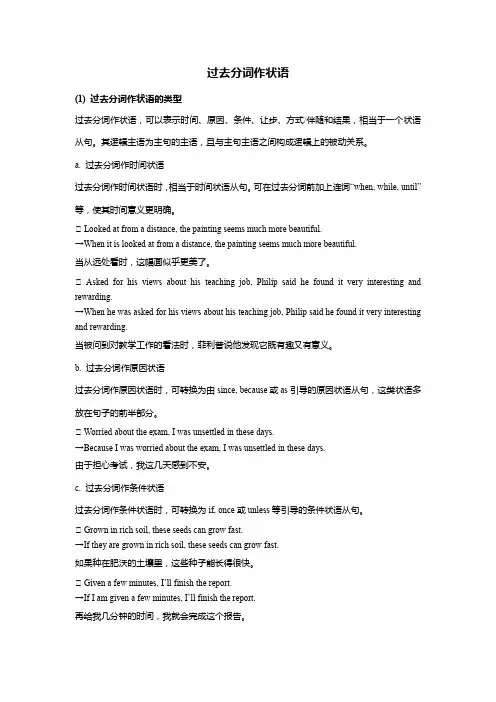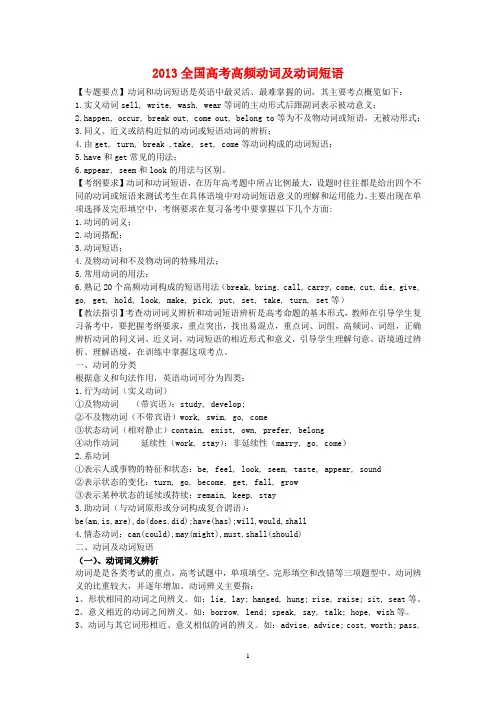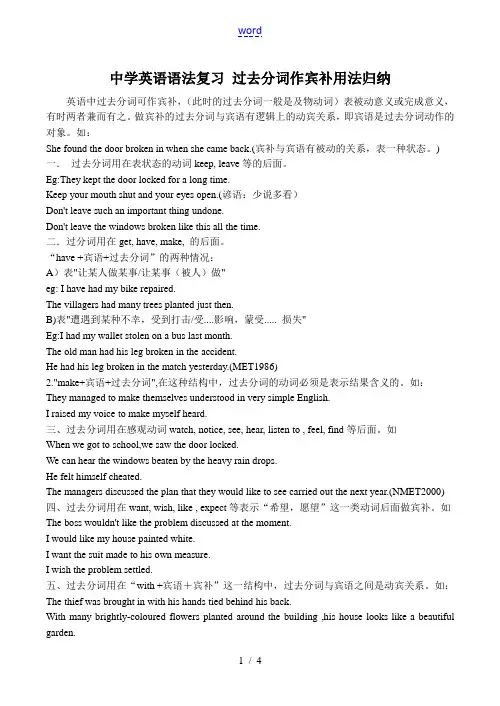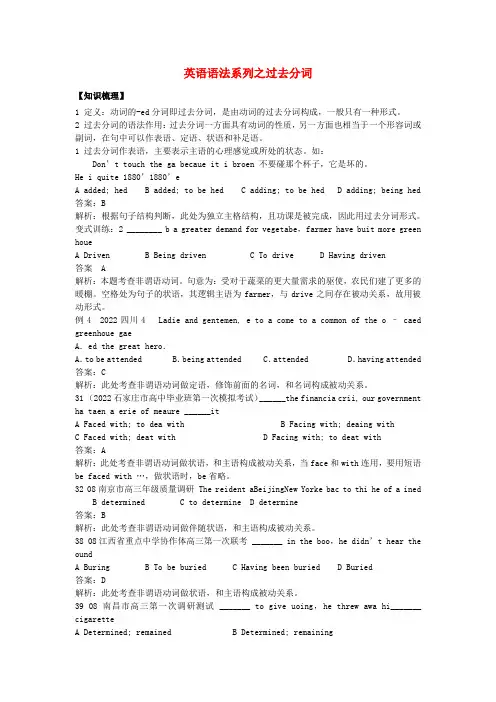2013届高考英语语法专题复习经典讲义过去分词归纳
- 格式:doc
- 大小:77.50 KB
- 文档页数:6

高中英语语法复习---非谓语动词-过去分词(总7页)-本页仅作为预览文档封面,使用时请删除本页-高中英语语法非谓语动词(三)过去分词非谓语动词(三)——过去分词(三)过去分词:1、过去分词的基本用法:过去分词只有一种形式,也没有主动语态,它所表示的动作是一个被动的或是已完成的动作。
过去分词在句中也可用作定语、表语、宾语或状语等成分。
过去分词在句中作某种成分时,其逻辑主语一般为该分词所表示的动作的承受者,如:(1)作定语:过去分词作定语时,如果这个分词是一个单词,就位于其修饰的名词之前,如果是分词短语,就位于其修饰的名词之后。
被过去分词所修饰的名词,就是该分词的逻辑主语,如:The stolen car was found by the police last week.(2)作表语:过去分词作表语时,表示其逻辑主语所处的状态,其逻辑主语就是句中的主语,如:The glass is broken.这个玻璃杯是破的。
注:过去分词作表语时,和动词的被动语态结构相似,但两者表达的意义不同,如:The glass was broken by my little brother.这个玻璃杯是被我小弟弟打破的。
作表语用的过去分词在许多词典中已列为形容词,如:crowded, devoted, discouraged, done, dressed, drunk, experienced, frightened, gone, hurt, interested, killed, known, learned, lost, pleased, satisfied, shut, surprised, tired, undressed, worried, astonished, broken, completed, covered等。
(3)作宾语补足语:过去分词作宾语补足语时,句中的宾语就是其逻辑主语,如:When I opened the door, I found the ground covered by fallen leaves. 注:动词have后的复合宾语中,宾语补足语如为过去分词,常表示该分词所表示的动作是由别人来执行的而不是句中主语自己来执行的,如:I had my bike repaired yesterday. 昨天我(找别人)把我的自行车给修了。

过去分词作状语(1) 过去分词作状语的类型过去分词作状语,可以表示时间、原因、条件、让步、方式/伴随和结果,相当于一个状语从句。
其逻辑主语为主句的主语,且与主句主语之间构成逻辑上的被动关系。
a. 过去分词作时间状语过去分词作时间状语时,相当于时间状语从句。
可在过去分词前加上连词“when, while, until”等,使其时间意义更明确。
◆ Looked at from a distance, the painting seems much more beautiful.→When it is looked at from a distance, the painting seems much more beautiful.当从远处看时,这幅画似乎更美了。
◆ Asked for his views about his teaching job, Philip said he found it very interesting and rewarding.→When he was asked for his views about his teaching job, Philip said he found it very interesting and rewarding.当被问到对教学工作的看法时,菲利普说他发现它既有趣又有意义。
b. 过去分词作原因状语过去分词作原因状语时,可转换为由since, because或as引导的原因状语从句,这类状语多放在句子的前半部分。
◆ Worried about the exam, I was unsettled in these days.→Because I was worried about the exam, I was unsettled in these days.由于担心考试,我这几天感到不安。
c. 过去分词作条件状语过去分词作条件状语时,可转换为if, once或unless等引导的条件状语从句。



英语语法系列之过去分词【知识梳理】1. 定义:动词的-ed分词即过去分词,是由动词的过去分词构成,一般只有一种形式。
2. 过去分词的语法作用:过去分词一方面具有动词的性质,另一方面也相当于一个形容词或副词,在句中可以作表语、定语、状语和补足语。
1) 过去分词作表语,主要表示主语的心理感觉或所处的状态。
如:Don’t touch the glass because it is broken.不要碰那个杯子,它是坏的。
He is quite pleased with the design of the dress. 她很喜欢那礼服的式样。
2) 过去分词做定语:单个的过去分词作定语一般放在名词的前面,相当于一个定语从句。
如:The excited people rushed into the building. 激动的人们奔进了大楼。
过去分词短语作定语通常放在被修饰的词后面,相当于一个定语从句。
Is there anything planned for tomorrow? 明天有什么活动吗?过去分词作定语也可用作非限制性定语,前后用逗号隔开。
如:The meeting, attended by one thousand students, was a success.这次会议获得很大的成功,共有一千个学生出席了。
3) 过去分词做状语:过去分词和-ing分词作状语一样,也可以表示时间、原因、条件、让步、方式或伴随情况等。
①表时间,相当于一个时间状语从句,有时过去分词前可加连词when或while来强调时间概念。
如:Seen from the top of the hill, the city looked like a big garden. 从山顶上看,这个城市就像一个大花园。
②表原因,相当于一个原因状语从句。
如:Deeply moved by the story, the excited people stopped quarrelling with each other. 激动的人们被那个故事深深地感动了,停止了争吵。

2013全国高考高频动词及动词短语【专题要点】动词和动词短语是英语中最灵活、最难掌握的词,其主要考点概览如下:1.实义动词sell, write, wash, wear等词的主动形式后跟副词表示被动意义;2.happen, occur, break out, come out, belong to等为不及物动词或短语,无被动形式;3.同义、近义或结构近似的动词或短语动词的辨析;4.由get, turn, break ,take, set, come等动词构成的动词短语;5.have和get常见的用法;6.appear, seem和look的用法与区别。
【考纲要求】动词和动词短语,在历年高考题中所占比例最大,设题时往往都是给出四个不同的动词或短语来测试考生在具体语境中对动词短语意义的理解和运用能力。
主要出现在单项选择及完形填空中,考纲要求在复习备考中要掌握以下几个方面:1.动词的词义;2.动词搭配;3.动词短语;4.及物动词和不及物动词的特殊用法;5.常用动词的用法;6.熟记20个高频动词构成的短语用法(break, bring, call, carry, come, cut, die, give, go, get, hold, look, make, pick, put, set, take, turn, set等)【教法指引】考查动词词义辨析和动词短语辨析是高考命题的基本形式,教师在引导学生复习备考中,要把握考纲要求,重点突出,找出易混点,重点词、词组,高频词、词组,正确辨析动词的同义词、近义词,动词短语的相近形式和意义,引导学生理解句意、语境通过辨析、理解语境,在训练中掌握这项考点。
一、动词的分类根据意义和句法作用,英语动词可分为四类:1.行为动词(实义动词)①及物动词(带宾语):study, develop;②不及物动词(不带宾语)work, swim, go, come③状态动词(相对静止)contain, exist, own, prefer, belong④动作动词延续性(work, stay);非延续性(marry, go, come)2.系动词①表示人或事物的特征和状态:be, feel, look, seem, taste, appear, sound②表示状态的变化:turn, go, become, get, fall, grow③表示某种状态的延续或持续:remain, keep, stay3.助动词(与动词原形或分词构成复合谓语):be(am,is,are),do(does,did);have(has);will,would,shall4.情态动词:can(could),may(might),must,shall(should)二、动词及动词短语(一)、动词词义辨析动词是是各类考试的重点,高考试题中,单项填空、完形填空和改错等三项题型中,动词辨义的比重较大,并逐年增加。


高中英语语法非谓语:过去分词的用法过去分词是非谓语动词的一种形式。
从语法功能分析,过去分词兼有动词、形容词或副词的特性,可在句中充当定语、表语、宾语补足语或状语。
过去分词通常与逻辑主语之间存在被动关系,表示被动或完成。
一、过去分词做定语1. 过去分词做定语时的意义不及物动词的过去分词做定语,只表示动作已完成,不表示被动的意义;及物动词的过去分词做定语表示被动意义或已完成的被动动作。
①只表示完成,不表示被动fallen leaves落叶a retired teacher一位退休的教师②表示被动或完成an honored guest一位受尊敬的客人a guided trip一次有导游的旅行the broken glass碎了的杯子the question discussed yesterday昨天讨论的问题a divided country一个分裂的国家2. 过去分词做定语时的位置①前置定语:单个的过去分词做定语,通常放在被修饰的名词之前。
The broken vase has been thrown outside.那个打烂的花瓶已被扔到外面去了。
The injured workers are now being taken good care of in the hospital.受伤的工人现在正在医院受到良好的照料。
②后置定语:过去分词(短语)做定语时,通常放在被修饰的名词之后,它的作用相当于一个定语从句。
I was instructed to carry out a plan supported (= which was supported) by most people.我被要求执行一个多数人支持的计划。
This will be the best novel of its kind ever written (= that has ever been written).这将是这类小说中写得最好的。

中学英语语法复习过去分词作宾补用法归纳英语中过去分词可作宾补,(此时的过去分词一般是及物动词)表被动意义或完成意义,有时两者兼而有之。
做宾补的过去分词与宾语有逻辑上的动宾关系,即宾语是过去分词动作的对象。
如:She found the door broken in when she came back.(宾补与宾语有被动的关系,表一种状态。
) 一.过去分词用在表状态的动词keep, leave等的后面。
Eg:They kept the door locked for a long time.Keep your mouth shut and your eyes open.(谚语:少说多看)Don't leave such an important thing undone.Don't leave the windows broken like this all the time.二.过分词用在get, have, make, 的后面。
“have +宾语+过去分词”的两种情况:A)表"让某人做某事/让某事(被人)做"eg: I have had my bike repaired.The villagers had many trees planted just then.B)表"遭遇到某种不幸,受到打击/受....影响,蒙受..... 损失"Eg:I had my wallet stolen on a bus last month.The old man had his leg broken in the accident.He had his leg broken in the match yesterday.(MET1986)2."make+宾语+过去分词",在这种结构中,过去分词的动词必须是表示结果含义的。
如:They managed to make themselves understood in very simple English.I raised my voice to make myself heard.三、过去分词用在感观动词watch, notice, see, hear, listen to , feel, find等后面。

英语语法系列之过去分词【知识梳理】1 定义:动词的-ed分词即过去分词,是由动词的过去分词构成,一般只有一种形式。
2 过去分词的语法作用:过去分词一方面具有动词的性质,另一方面也相当于一个形容词或副词,在句中可以作表语、定语、状语和补足语。
1 过去分词作表语,主要表示主语的心理感觉或所处的状态。
如:Don’t touch the ga becaue it i broen不要碰那个杯子,它是坏的。
He i quite 1880’1880’eA added; hedB added; to be hedC adding; to be hedD adding; being hed 答案:B解析:根据句子结构判断,此处为独立主格结构,且功课是被完成,因此用过去分词形式。
变式训练:2 ________ b a greater demand for vegetabe,farmer have buit more green houeA DrivenB Being drivenC To driveD Having driven答案 A解析:本题考查非谓语动词。
句意为:受对于蔬菜的更大量需求的驱使,农民们建了更多的暖棚。
空格处为句子的状语,其逻辑主语为farmer,与drive之间存在被动关系,故用被动形式。
例4 2022四川4 Ladie and gentemen, e to a come to a common of the o – caed greenhoue gaeA.ed the great hero.A.to be attended B.being attended C.attended D.having attended 答案:C解析:此处考查非谓语动词做定语,修饰前面的名词,和名词构成被动关系。
31 (2022石家庄市高中毕业班第一次模拟考试)______the financia crii, our government ha taen a erie of meaure ______itA Faced with; to dea withB Facing with; deaing withC Faced with; deat withD Facing with; to deat with答案:A解析:此处考查非谓语动词做状语,和主语构成被动关系,当face和with连用,要用短语be faced with …,做状语时,be省略。

高中英语语法专题复习03 非谓语动词(不定式、动名词&现在分词、过去分词)非谓语动词谓语动词在句子中有三种作用:1. 表示动作的时间,tense (时)2. 表示动作的状态,aspect (体)3. 表示动作的语气,mood (气)谓语动词的“时体气”,通过动词变位实现。
例如,The rabbit ate a carrot.The rabbit is eating a carrot.The rabbit has eaten a carrot.谓语动词在句子中受到主语的限制,随之出现了时态和人称的变化,成为一种被限定了的动词,所以也被称为限定性动词(finite verb)。
与之相对的,不受主语限制的动词,称为非限定性动词(non-finite verb),也就是非谓语动词。
非谓语动词不具备表达时态和人称的作用。
例如,I like to eat carrot.I liked eating carrot.The rabbit likes minced carrot.非谓语动词有四种形式:1. 不定式 infinitive2. 动名词 gerund3. 现在分词 present participle4. 过去分词 past participle谓语动词是简单句的核心动词,非谓语动词只可能出现在其他的句子成分中。
1. 主语例:Swimming makes us hale and hearty.2. 宾语例:Janet suddenly stopped talking.3. 表语/主语补语例:Her wish is to become a doctor in the future.4. 宾语补语例:I invited him to come here.5. 定语例:Don't disturb the sleeping dog.6. 状语例:He went to the supermarket to buy a pen.不定式、动名词句子的核心动词只能由谓语动词充当,而非谓语动词可以充当句子的其他成分。
高中英语语法:情态动词10条学习要点“could+have+过去分词”用法全面归纳有关情态动词的10条学习要点1. 弄清基本语法特点情态动词就是表示说话的语气或情态的动词。
常见的情态动词有can, may, must, need, dare, shall, will, should, ought to, have to, used to, had better, would rather等。
情态动词具有以下3个特点:(1)情态动词后面接动词原形并与动词原形一起构成谓语。
(2)情态动词虽有时态的变化,但却没有人称和数的变化,即情态动词不会因为主语的人称或单复数的不同而用不同的形式。
(3)变为疑问句或否定句时不需要助动词,而是将情态动词移至主语前变为疑问句,直接在情态动词后加not,构成否定句。
2. 弄清表示能力的can / could和be able to的用法(1)can表示具有某种能力或技能,意为“能,会”。
如:Who can answer this question? 谁能回答这个问题?(2)can 的过去式为could,但它通常只表示过去一般性能力,不表示过去特定场合下的能力,遇此情况要用was [were] able to。
如:I could run faster then. 我那时能跑得更快一些。
They were able to jump into the sea before the boat was blown up. 他们在船爆之前跳入海里。
3. 弄清表示许可的can / could / may / might / must的用法can / could / may / might均可表示许可,只不过may较侧重讲话人的许可,而can较侧重客观情况的许可;could / might的语气比can / may更委婉、客气;在答语中表示允许别人做某事要can / may,不能用could / might。
2013届新课标高考英语精华知识点终极解密专题07 动词的-ed形式动词的-ed形式也是非谓语动词的一种,它具有动词的一些特点,同时也具有形容词、副词的句法功能,在句中可用作表语、定语、状语和宾语补足语等。
一、动词的-ed形式的特征A.动词的-ed形式是由动词的过去分词构成动词的-ed形式只有一种形式,即传统语法中的过去分词。
绝大部分的动词的-ed形式由动词原形加-ed构成,也有一些动词的-ed形式是不规则的。
1.规则动词的-ed形式limit→limited(限制)pr etend→pretended(假装)escape→escaped(逃脱)provide→provided(提供)refer→referred(提交)drag→dragged(拖)pray→prayed(祈祷)supply→supplied(供应)2.不规则动词的-ed形式cast→cast(投掷)spread→spread(传播)bite→bitten(咬)forgive→forgiven(原谅)spit→spat(吐)we ar→worn(穿)fight→fought(搏斗)lose→lost(丢失)3.少数动词的-ed形式作定语时,读音与一般过去分词不同learned a learned professor 一位知识渊博的教授aged an aged man 老人beloved his beloved computer 他心爱的计算机B.动词的-ed形式的否定形式动词的-ed形式的否定形式是由not或never加动词的-ed形式构成。
Not allowed to go in, he had to wait outside. 不允许他进去,他只好在外面等着。
Never invited to his party, she got angry with him. 从未被邀请过去他的聚会,她很生气。
C.动词的-ed形式的特征动词的-ed形式有被动的意思,有时也可表示完成的动作。
2013届高考英语语法专题复习经典讲义过去分词归纳i.形式和性质:1.过去分词只有一种形式,即v-ed。
没有所谓的“一般体”“进行体”与“完成体”之分。
过去分词也没有“主动式”与“被动式”之称谓。
2.过去分词一般有以下特征:2.1 被动性:过去分词的逻辑主语是分词动作的承受者(receiver), 而不是发出者(doer)。
2.2 完成性:与句中另一个动作、另一个时间或句子产生的时间相比,分词的动作往往先已发生。
〖分析〗1. the injured man (=the man who had been injured)was sent to hospital without delay.2. this is the book borrowed (= which was borrowed) from the school library last week.3. done in a hurry(because it had been done in a hurry), tom's homework was full of mistakes and errors. 〖例外〗1. 在使役动词后作宾补的过去分词和带有将来时间状语的分词不具完成性。
如:i'll have my house enlarged.the car repaired this afternoon belongs to one of my friends.2. 一些不及物动词的过去分词作定语时,不具被动性。
an old man was collecting the fallen leaves in the yard.the police were searching for the escaped man.ii. 句法功能1. 主语过去分词前加上定冠词可用作主语,表示一个类别的人(事物)。
如:the accused have been acquitted.the wounded were left hidden in that village .这种用法时,谓语一般用复数动词,但在上下文明确时也可能用于指一类中的个别,用单数动词。
如: the deceased is his father.the wounded is a policeman.2. 宾语过去分词前加上定冠词可用作宾语,也表示一个类别的人(事物)。
如:everyone in our society should respect and help the disabled.listen to the voice of the oppressed .3.表语the boys were astonished.the door remained locked.they seemed worried.he is wel l known to us all.4.定语4.1 前置定语由单个分词充当the broken glass is still lying on the table.the frightened girl was trembling when the police arrived.this sort of people seems not to be able to live in the ch anged wo rld.he only collects used stamps.this phrase is often used in spoken english.a grown boy is a boy who has physically and mentally grown up.the risen sun is the sun that has risen high.that was a man-made satellite.he sent they his newly-invented devices.4.2 后置定语由分词短语充当she was reading a novel written by dickens.he works and lives in a school surrounded by green trees.the people trapped in the big fire were rescued by the firefighters with a helicopter.the radio bought in your shop doesn't work well.the braille is a language used for the blind.偶尔也有单个分词作后置定语的情况。
如:things seen are mightier than things heard.有时单个分词作前置定语与作后置定语的意义不同。
如:the car used was a stolen one. (the car which was used at the time…)the used car was still in the garage.( the old car which didn't wo rk well… )5.宾补5.1 在感觉/ 知动词后:see, look at, observe, hear, listen to, think, find, imagine, feel, watch等。
we found him greatly changed.everyone thought the battle lost except the general.he felt himself carried onto a carriage .i have never heard a single french word spoken before.the worst part was watching her wheeled away to an operating theatre while we waited and stared at the walls. (collins gp1:verbs, p.308)5.2 在使役动词后:make, have, get, keep, leave等。
he tried to make yourself understood in his broken english.i had my bad tooth pulled out yesterday.last month the family got a new house built.it's very important for you to keep your parents informed of your situation.he left the food untouched and went out.5.3在意愿动词后:like, need, want, order, wish等。
he won't like the problem discussed at the meeting.they were arrested by immigration officials on monday just hours after a high court judge had ordered them freed from detention. (collins gp1:verbs, p.306)she came into the shop with a package saying: "i don't need it changed, only re-wrapped."the king ordered the magic cloth woven at once.i want the case investigated further to make every detail clear.6.状语6.1 方式和伴随情况( of manner or accompaniment )he walked around outside, disturbed by the news.the teacher went out, followed by some pupils.the old man sat on the chair, lost in thought.three large men rushed out of the house, armed with guns and knives.supported by a girl, the old lady got off the bus.表示方式的as if 和as though 可与过去分词连用。
如:he walked back as if hurt in t he leg.6.2 条件(of condition)heated to a high temperature, water changes into vapor.given more time, we could do it better.criticized by someone else, she could not have got so angry.painted white, the house will appear nicer.表示条件的过去分词可与连词if 和unless 连用。
i will not go to tom's party unless invited.i'll tell everything to the police if questioned about that.6.3原因和理由(of reason or cause)done in a hurry, tom's exercise was full of mistakes.made of glass, the test tubes are easy to break.wounded badly, he was sent to hospital.tired with the trip, they went to bed early.shocked by the sudden attack of the german army, the poland government was at a loss what to do.表示原因的分词没有相应的连词可用。